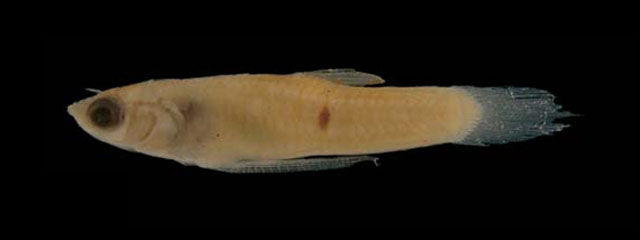|
Dorsal soft rays (total): 8-8; Anal soft rays: 9-11; Vertebrae: 32-33. Distinguished autapomorphically by functional gonapophyses on vertebrae 15, 16, and 17, and also differs from congeners by the width of first pelvic-fin ray in adult males approximately constant tapering gradually to tip. Can be separated from other species of the genus Phalloceros, except Phalloceros megapolos, Phalloceros spiloura, Phalloceros anisophallos, Phalloceros alessandrae, Phalloceros buckupi, Phalloceros uai, Phalloceros lucenorum, Phalloceros pellos, and Phalloceros reisi by the female urogenital papilla curved to the right, located laterally (vs. slightly left turned and with a lateral ramus or straight located along midventral line), and border of the anal aperture in contact with the first anal-fin ray or very close to it (vs. separated from first anal-fin ray by the female urogenital papilla). Can be distinguished from Phalloceros megapolos by the gonopodial appendix normally developed
(vs. greatly expanded in wing like expansions); and from Phalloceros spiloura, Phalloceros anisophallos, Phalloceros buckupi, Phalloceros uai, Phalloceros lucenorum, Phalloceros pellos, and Phalloceros reisi by the halves of gonopodial paired appendix slender, not sickle like, and similar to each other (vs.
Sickle like and different from each other), bearing a medial corner (vs. medial corner absent); and hooks on both halves of gonopodial paired appendix (vs. right half hook absent).
Differs from Phalloceros alessandrae by gonopodial appendix strongly arched at
the distal tip (vs. straight at the distal tip); distal portion bent upward (vs. distal portion straight and oblique forming a 45°angle with the vertical axis); and left and right halves free not coalescent at the base (vs. coalescent at the base) (Ref. 76852).
Description: Pectoral fin with 6 branched rays; longitudinal series of scales 28-30; transverse series of scales 7 (Ref. 76852). |

